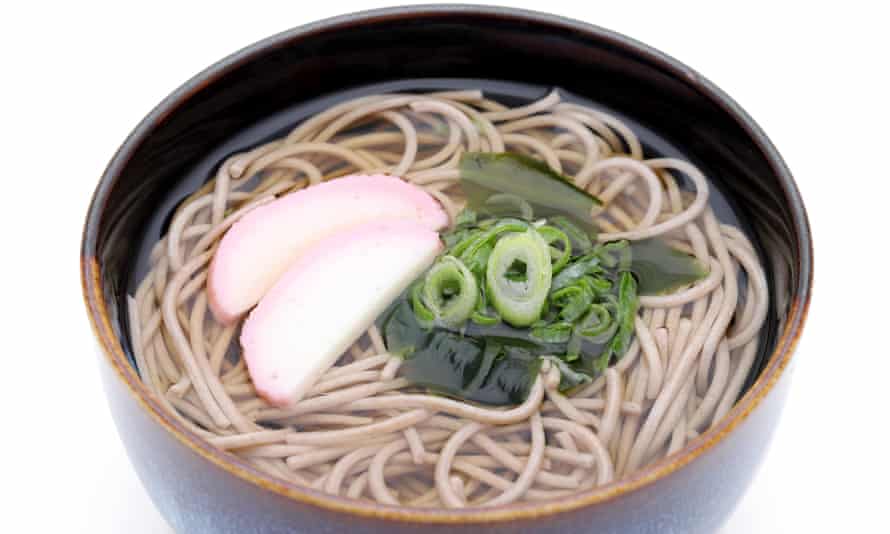Every year my mother would make a bowl of Japanese New Year’s Eve noodles for my American father and me. “Just this one tradition,” she would entreat; she didn’t like American New Year, and longed for Japanese-style festivities. One year, I found one of my noodles tied in a knot, which she assured me was a sign of good fortune. I wasn’t so sure. I didn’t even really like noodles.
It was not until I was in my 20s that I experienced a full winter holiday in Japan. On New Year’s Eve, my family went to visit friends in Handa, my mother’s home town about 350km west of Tokyo. We counted down the hours with sake and sushi and then, close to midnight, went to the local shrine.
In the film that makes up my memory of that night nearly 30 years ago, people laugh and shout and eat and slurp with unrestrained joy; it was dark and cold but we had entered a new year together and everything felt possible, as though we mountaineers were at the peak of a mountain we had once again scaled. I was handed a small mound of noodles flecked with gold. I balked. I had never been fed gold before. “It’ll make you rich,” someone urged. So I ate the noodles with the gold, ingesting in food form the cultural wish that I be fed, wealthy and hale as the year rolled on.
The very shape of the noodle was meant to ensure a long life and safely bind us from one year to the next. The chewy texture and hearty flavour captured the speed of assembly and the unrestrained, informal midnight joy of locals celebrating together. The glistening noodles were all practicality, optimism, sensuality and comfort – and I loved them.
Now, when I travel the Japanese countryside, I look for queues of people outside unassuming buildings with plumes of steam rising out of rooftop vents. I have seen this at Ugo during the Nishimonai Bon Odori festival (a kind of Day of the Dead), outside Kyoto’s Omen restaurant, and on the island of Shikoku while on the 88-temple pilgrimage. “Excuse me,” I always ask the person at the end of the queue. “Why are you lining up?” “For noodles,” they always say.
This year, noodles took on greater poignancy. My small family – husband and child – would not mind whether they ate noodles or not. But the tradition has been hammered into me, and I threw together a simple broth, cooked the buckwheat noodles and defrosted the traditional pink-and-white fishcake. I snipped green onions with a pair of small scissors my mother had in her kitchen just for this purpose. The more finely the green onions are cut, the Japanese say, the better the flavour. “Scissors will give you better control,” my mother had told me. I had no flakes of gold, so dotted the noodles with a little shaved hard-boiled egg yolk. It was New Year’s Day and I was a little late, but I still had time to feed us correctly.
Then, as my mother had done in the past, I gave the noodles to my family. “The reason we eat the noodles,” I said, “is because they are long, and they are meant to tie us from the previous year into the new one. That’s part of the good luck.” On social media, more assiduous friends posted beautiful pictures of their midnight noodles. I confessed to my slapdash job. “But I got us covered,” I wrote.

Japanese new year noodles
Serves 4
250g soba (buckwheat) noodles
60ml tsuyu broth (available in most Asian grocery stores)
500ml water
1 bunch (65g) spring onions, finely chopped
160g kamaboko (cured fishcake, available in Japanese supermarkets)
2 eggs, hardboiled
Shichimi (Japanese seven-spice powder), to taste
Mix the tsuyu broth with the water and heat in a pan. Thinly slice the spring onions, or cut with scissors. (In my family, we cut up lots of spring onions then freeze the pieces in a plastic bag or box, removing only what we need for each meal.)
Slice the fishcake into even pieces, perhaps 10mm. Cut the eggs in half and remove some yolk from each. Boil and drain the soba noodles. Place a helping of the drained noodles and half an egg in each serving bowl.
Ladle the soup broth over the noodles, and garnish with crumbled egg yolk, shichimi if you have it, fishcake and spring onions.
• Marie Mutsuki Mockett’s latest book is American Harvest: God, Country, and Farming in the Heartland





